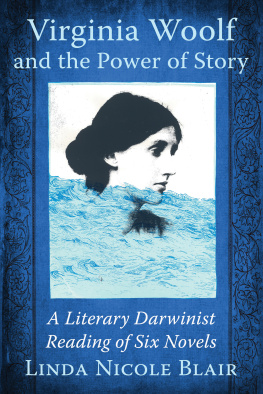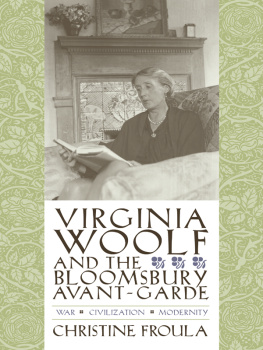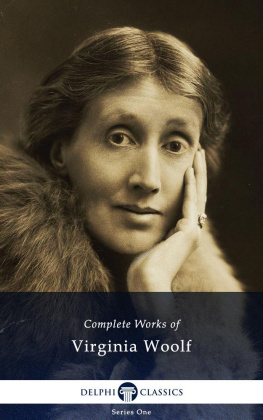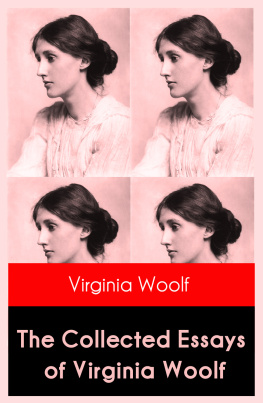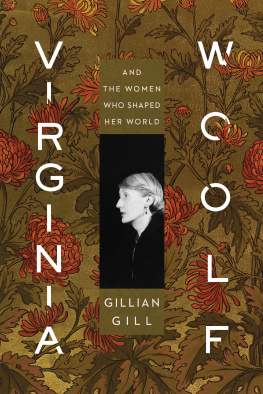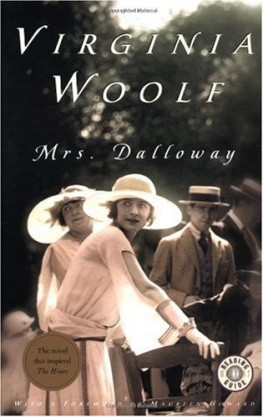Contents
Guide
Pagebreaks of the print version

The author and publisher have provided this e-book to you for your personal use only. You may not make this e-book publicly available in any way. Copyright infringement is against the law. If you believe the copy of this e-book you are reading infringes on the authors copyright, please notify the publisher at: us.macmillanusa.com/piracy.
For Joanne Goldstein,
who was born in 1922,
and for Blake West,
who lived through it with me.
The world broke in two in 1922 or thereabouts.
Willa Cather, Not Under Forty
Some years are understood as pivotal in history1492, 1776, 1865, 1914, 1945, 1968. Nineteen twenty-two is a dividing line in literary history. The World Broke in Two tells the story of 1922 by focusing on four legendary writers: Virginia Woolf, T. S. Eliot, E. M. Forster, and D. H. Lawrence, who were all similarly and serendipitously moved during that remarkable year to invent the language of the future.
Willa Cather began her 1936 book of essays, Not Under Forty , with the melancholy remark about changes in literary fashion: The world broke in two in 1922 or thereabouts. Cather was thinking of the publication of Ulysses in February and of The Waste Land in October of 1922, and the ways in which those works seemed, all at once, to herald a new modernist era in which the form of storytelling she prized, and had excelled at, was no longer of signal importance. Her own novel of the war, One of Ours , was published in 1922 and won the Pulitzer Prize in 1923. But Joyces novel and Eliots poem, and the coincidence of their publication dates, had very quickly given 1922 a privileged place in the history of literary modernism in which she and her work seemed to have no share. She was a relic of an old literature the value of which had not been preserved against the new literature that Joyce and Eliot represented.
For Woolf, Eliot, Lawrence, and Forster, the literary apocalypse of 1922 had less to do with publication dates than with the personal and creative challenges that indeed broke the world in two for them in 1922. Woolf, Forster, Eliot, and Lawrence were, at the start of 1922, writers in deep despair, privately confronting an uncertain creative future; each of them felt literally at a loss for words. None of these essential pillars of twentieth-century literature could foresee the work just ahead that was about to transform them as writers. The Waste Land was published in 1922but the drama of the year for Eliot had less to do with the poems appearance than with how close he had come to not finishing it or having it published at all.
Renewal came as each in turn experienced a sudden, if still tentative, spark of vision. In early spring, Woolf thought to write again of a character who had appeared in her first novel, The Voyage Out , published in 1915: this was Clarissa Dalloway. Forster, picking up the abandoned manuscript of what was to become A Passage to India, made his first significant progress on a work of fiction in eight years. Both of them began to read the first volume of Prousts la recherche du temps perdu , in French, which inspired their work, and on which both drew as they continued to work through 1922 and beyond. Lawrence started Kangaroo , his neglected but perhaps most autobiographical novel, written at light speed during his hundred-day sojourn in Australia that spring and summer. And Eliot, stopping in Paris for two weeks with Ezra Pound, began editing his poem into a 450-line distillation of his years of intermittent and sometimes aimless work. By the end of the year, the blank pages facing them in January were filled: theyd found the words, or were making new words, new forms, new styles, reworking the words into new shapes.
Rivalries and jealousyincluding with James Joyce and the specter of his Ulysses had a role in these writers renewed creativity, as did the various ways each of them gained fresh publicity, and increasing renown, as 1922 progressed. Reviving the joy at the heart of their endeavors in 1922 is one of the goals of The World Broke in Two . In February 1922, Virginia Woolf looked over her shoulder at her friends and rivals and remarked in her diary with a mix of admiration and awful surprise, How these writers live in their worksHow ambition consumes them! How right she was.
* * *
It is after all a grrrreat littttterary period, Ezra Pound wrote to T. S. Eliot in January 1922.
This was a prophetic sentiment Eliot, or Virginia Woolf, E. M. Forster, or D. H. Lawrence, was unlikely to have shared at that moment. Most people begin a new year with a sense of resolution, a glimmering hope that by this time next year dreams will have come true, or plans been achieved, or nascent ideas become novels or poems. For these four authors, all among the major writers of the twentieth century, the year 1922 began, frighteningly, with a blank page even more starkly empty than usual because of personal travails and the open questions of form, style, and subject that haunted them all. Their shared questions were based in a shared fear: that a great (in plain English) literary period Pound foretold might be approaching, but it would pass them by.
Virginia Woolf turned forty on January 25, 1922. It was an unhappy milestone. For weeks before and after the dreaded birthday, she was stranded in bed, apparently the favourite breeding ground of the influenza germ, and alternately preoccupied by a lingering fever and her equally persistent failure to have yet written a novel that commanded the precise quality of literary esteem she aspired to.
After years spent strenuously avoiding writing fiction, her friend E. M. Forster had likewise become painfully conscious of past and impending failures of his own, and of his evaporating prominence. So here I am with 3 unfinished novels on my hands. Even mother must notice Im played out soon, he had written in his diary as long ago as December 1913. One of these was his Indian fragmentseventy-five pages of which he abandoned the next year, before the world war. Born on New Years Day, 1879, Forster celebrated his forty-third birthday on the first day of 1922, and as January got under way he was literally at sea, on his way home after having spent most of 1921 in India, more time abroad that he had hoped would offer some direction for the latest of his incomplete novels. But when he returned to England in March 1922 from the Indian sojourn that was meant to inspire him, he was no less adrift than before. As a writer and as a man, he was trapped, having struggled with an unrequited love for Mohammed el Adl, the married Egyptian tram conductor whom hed met in Alexandria during the war, as laboriously as hed wrestled with his continuing failure in fiction. That he was well into middle age and living with his mother was lost on no one, least of all himself.
T. S. EliotThat strange young man Eliot, as Virginia once called himwas as uncertain of himself and his work, as adrift, as Forster and Woolf were. He marked the start of 1922 in Lausanne, Switzerland, recovering from a nervous breakdown so severe he had left his job at Lloyds Bank for a three-month rest cure in October 1921. Eliots distress, in part, was rooted in the sense of failure he shared with Woolf and Forster. Eliot, during his Lausanne treatment and in London before and after it, had to face down his inability to make any real headway on a long poem he had been contemplating for years. The many disparate pieces of what would become The Waste Land consisted in part of lines and fragments written during the war and before, including some bits from his undergraduate days at Harvard. For many years, the poem existed only in the future tense. Eliot could not put it together in a coherent way, and the frustrations and collapse that shadowed him as 1922 began were the culmination of years of attenuated effort.


